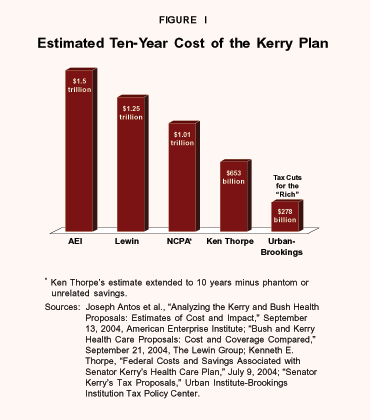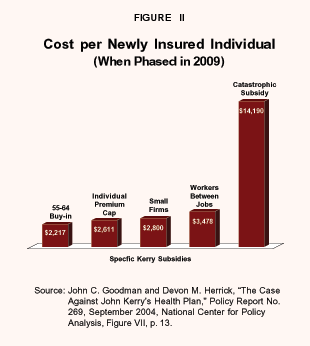Sen. John Kerry has a plan to radically change the U.S. health care system. If he is successful, millions of middle-income families will be enrolled in Medicaid, the federal-state health program for the poor. Millions more will get their insurance through a system of managed competition modeled after the federal employee's health system and similar to what Hillary Clinton proposed more than a decade ago. Most people would not be able to continue in the private health plans they have today.

The Plan. Kerry's program has no mandates. Instead, it would use economic incentives to induce people to acquire public or private health coverage. Very few of the subsidies will actually go to individuals, however. About 90 percent of the funds will go to state governments, employers and insurance companies.
The Kerry proposal uses existing federal programs to extend health insurance coverage. First, the federal government would pay the full costs of 20 million children in Medicaid, in exchange for states expanding coverage to more people under the Medicaid and State Children's Health Insurance Program (SCHIP) – in some cases to people with incomes at three times the poverty level. Second, Kerry would create the Congressional Health Plan, similar to the Federal Employees Health Benefits Plan (FEHBP), to offer insurance to individuals and employer groups. Third, the Kerry plan would have the federal government "rebate" three-fourths of employers' catastrophic health claims costs (above $30,000 per beneficiary in 2006, rising to a projected $50,000 in 2013) if employers offer insurance to all employees and pay one-half the premium costs.
Additional proposed subsidies for many who insure through the Congressional Health Plan include:
- A refundable tax credit for small businesses that pay for at least 50 percent of the cost of employee health insurance;
- A 75 percent tax credit for workers between jobs and a 25 percent tax credit for workers age 55 to 64 years; and
- A limit on how much insurance could cost (6 percent of income at the poverty level, rising to 12 percent at 300 percent of poverty) for everyone else who individually enrolls.
Spending. The effort will be expensive. Emory University Professor Kenneth Thorpe, who helped construct the Kerry Plan, estimates the plan will cost $952 billion over nine years. However, Thorpe reduces his projected costs about $299 billion by including savings to the federal government that other estimates judge to be unrealistic or unrelated to the basic plan.
- If Thorpe's estimate is extended for 10 full years of operation and if questionable savings are ignored (the NCPA estimate), the costs exceed $1 trillion over 10 years – an amount equal to almost $1,000 per year for every household in America.
- But the Lewin Group, a respected health care consulting firm, estimates a higher cost of $1.25 trillion over 10 years.
- And, an estimate by former government health officials and actuaries for the American Enterprise Institute projects a cost of $1.5 trillion over 10 years. [See Figure I.]

Paying for the Plan. Why are these cost estimates so important? Because Sen. Kerry has promised the vast majority of voters something for nothing. He promises health benefits to 98 percent of the population to be paid for by higher taxes on the other 2 percent. Specifically, Sen. Kerry proposes to pay for the net cost of his plan by repealing President Bush's tax cuts for high income taxpayers. However, these tax increases are nowhere near enough to finance the Kerry health plan.
Thorpe estimates that ending the Bush tax cuts for those making $200,000 or more would raise $860 billion. However, the tax cuts are already due to expire – and those revenues have been included in the federal budget that Kerry has promised to balance. As Figure I shows, a repeal of tax cuts for the top two tax brackets would yield only an additional $278 billion – an amount equal to only one-third to one-fifth of what is needed.
Is the Spending Necessary? The ostensible purpose of Kerry's plan is to insure the uninsured. However, two-thirds of the spending under his plan would go to reduce the cost of insuring people who are already insured. Moreover, the expansion of federal health programs will almost certainly crowd out private coverage. That is, employees will drop out of employer plans in order to enroll in public programs. And companies that employ large numbers of newly-Medicaid-eligible employees will tend to drop their health plans altogether.
Thorpe assumes that for every 10 new Medicaid enrollees under the Kerry plan, three people will lose private coverage. Thus, to insure 18 million net new people through Medicaid expansion (the Kerry goal) he must enroll about 26 million additional people in Medicaid. Thorpe's assumption is probably too conservative. Actual crowd out could be as high as one for one. It has happened before. During the 1990s, taxpayers funded a large expansion of Medicaid and SCHIP. But as government insurance grew, private insurance contracted – leaving the fraction of the uninsured population virtually unchanged.
The Real Goal of the Kerry Plan. The Kerry plan has numerous subsidies. If the goal were to maximize the number of people with insurance at minimum taxpayer expense, then the last dollar spent on any one subsidy should cause just as many people to become insured as the last dollar spent on any other subsidy. But as Figure II shows, this is clearly not the case. Thorpe's estimates show that the cost to insure one new person varies from $2,217 for the near-elderly (55 to 64) subsidy to $14,190 for the employers' catastrophic expense subsidy.
Real Goal – Reform the System. If the goal is not to insure the most number of people for the least amount of money, what is the purpose of this plan? It's hard to escape the conclusion that the real purpose is to remake the health care system.
John C. Goodman is president of the National Center for Policy Analysis.